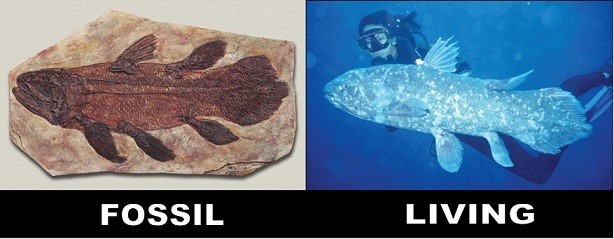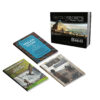No products in the cart.
Return To ShopTiktaalik & Coelacanth: Transitional Fossils?
Tiktaalik is also a widely-used “transitional” fossil in textbooks—supposedly representing a missing link between fish and four-legged creatures that first walked on land.

Tiktaalik is typically shown in textbooks as a 375-million-year-old fossil that was “on its way” to progressing into a land-dwelling creature. Sometimes the Coelacanth is also shown in this same line-up, supposedly living about the same timeframe.[ii]

Now, however, both fish have been ejected out of the evolutionary line-up. Until recently, evolutionists thought that Tiktaalik’s strong front fins did most of the work to pull this “transitional fish” up onto land, leaving the hind legs to evolve later. However, after more investigation of Tiktaalik’s pelvis and pelvic fins, the discoverers of Tiktaalik have developed updated illustrations showing how it used its strong pelvic structure for paddling. Now they believe that Tiktaalik’s hind-parts had so much power that it had “pelvic-propelled locomotion”[iv] (see Figure 3).

Even more amazing is the fact that scientists announced in 2010 in the journal Nature that they had found footprints of a four-legged land creature in Poland that they deemed ten million years older than Tiktaalik.[vi] How could land creature fossils exist 10 million years before their ancestor?
The story behind the Coelacanth is even more amazing. Evolutionists believed that these creatures lived between about 400 million and 66 million years ago, but they were found living in 1938![vii]

Coelacanths were used in textbooks for decades to promote evolutionary teaching because their fins looked to evolutionists like they were in the primitive first stages of becoming arms and legs. This made coelacanths a perfect fit for the supposed transition from sea to land creatures.
But all of this changed on December 23, 1938, when Marjorie Courtenay Latimer, a curator in a museum in South Africa found one alive. She went to the docks to wish the crew of the fishing ship named “Nerine” a merry Christmas. After delivering her greetings, she noticed “a blue fin protruding beneath a pile of rays and sharks on the deck. Pushing the overlaying fish aside revealed, as she would later write, ‘the most beautiful fish I had ever seen, five feet long, and a pale mauve blue with iridescent silver markings.’”[ix] At first, she had no idea what the fish was, but after careful examination, it turned out to be a real, living Coelacanth. This discovery was such a shock among scientific circles that it was named the “zoological discovery of the century.” In 1998, another Coelacanth population was found in northern Sulawesi, Indonesia, where the locals call it “rajalaut”—which means “king of the sea.” How did this creature not evolve for over 300 million years? The fact is, it didn’t. It’s probably very close to the original design blueprint God used to create it!
[i] See: www.en.wikipedia.org/wiki/Tiktaalik (February 16, 2016).
[ii] Z. Johanson, J.A. Long, J.A. Talent, P. Janvier, J.W. Warren, “Oldest coelacanth, from the Early Devonian of Australia,” Biology Letters 2 (3) (2006): 443–6
[iii] See: www.en.wikipedia.org/wiki/File:Fishapods.png
[iv] Shubin N. et al., “Pelvic girdle and fin of Tiktaalik roseae,” Proceedings of the National Academy of Sciences (13 January 2014); see also: www.answersingenesis.org/extinct-animals/did-tiktaaliks-pelvis-prepare-fish-to-walk-on-land/ (February 16, 2016).
[v] Neil Shubin, “Tiktaalik roseae fossil analysis provides new details on the origin of vertebrate legs,” (University of Chicago, January 13, 2014). Phys.org: www.phys.org/news/2014-01-discovery-tiktaalik-roseae-fossils-eveals.html#jCphttps://phys.org/news/2014-01-discovery-tiktaalik-roseae-fossils-reveals.html (November 5, 2018).
[vi] Philippe Janvier & Gaël Clément, “Palaeontology: Muddy tetrapod origins,” Nature 463, 40–41 (January 7, 2010).
[vii] Smith C. Lavett, Charles S. Rand, Bobb Schaeffer, James W. Atz, “Latimeria, the Living Coelacanth, is Ovoviviparous,” Science 190 (4219) (1975): 1105–6.
[viii] Credit: www.cecwisc.org/Content/files/2013/09/Coelacanth-1.jpg
[ix] See: www.dinofish.com/discoa.htm









